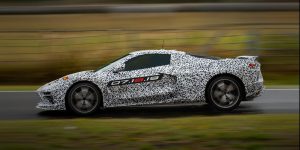Benefits of a Mid-Engine Vehicle
Posted Wednesday, Jul 17, 2019
 As most people know, Chevrolet will reveal the mid-engine C8 Corvette tomorrow. I recently read some comments online from the debate as to whether or not Chevy should make a mid-engine ‘Vette or keep the front-engine layout that’s been around since 1953. To be sure, Chevy would only abandon this 66 year-old platform if there were benefits of doing so. So, what are the benefits of a mid-engine vehicle?
As most people know, Chevrolet will reveal the mid-engine C8 Corvette tomorrow. I recently read some comments online from the debate as to whether or not Chevy should make a mid-engine ‘Vette or keep the front-engine layout that’s been around since 1953. To be sure, Chevy would only abandon this 66 year-old platform if there were benefits of doing so. So, what are the benefits of a mid-engine vehicle?
The short answer is weight distribution, or what percentage of the car’s weight rides over each axle. Obviously, having the weight balanced would provide for a car with better handling since it would be neither nose-heavy nor tail-heavy.
Now for the long answer: weight distribution and inertia, a discussion of which necessitates some groundwork. In most specifications of vehicles, you will find the weight distribution listed as a ratio, like 53/47, with the first number being the percentage of the car’s weight over the front. If we look at the weight distribution of several 2019 cars, we find that most sports cars are pretty balanced (except the Porsche 911 and Honda Civic):
Honda Civic Type R- 68/32
Porsche 911 Carrera S- 39/61
Ford Mustang GT- 54/46
Porsche 718 Cayman- 46/54
BMW M2- 52/48
Mazda MX5- 50/50
Chevrolet Corvette Z06- 50/50
Even though this is a short list, it covers many criteria: 2 are Japenese, 3 are German, and 2 are American; 1 is a sedan, 1 is a roadster, and 5 are coupes; 1 is front-engine/front-wheel drive, 1 is rear-engine/rear-wheel drive, 1 is mid-engine/rear-wheel drive, and 4 are front-engine/rear-wheel drive. Admittedly, the Civic and 911 skew the list in opposite directions concerning balance, but that’s to be expected: the Civic is front/front, and the 911 is rear/rear. In other words, the drivetrain of the Civic is entirely in the front of the vehicle (nose-heavy) while the 911’s is entirely in the rear (tail-heavy).
It’s quite a generalization, but most nose-heavy cars will understeer (tend to push straight through a turn) while most tail-heavy cars will oversteer (send the rear around you in a turn). Though oversteer can be great fun when intended, neither sliding straight through or spinning around in a turn helps one’s lap times. Hence, a balanced car can offer the best handling, and placing the engine in the center of the car helps reach that balance.
You may have noticed, though, that the Mustang GT and Cayman in the list above have equivalent weight distribution ratios (albeit inverted) even though the Mustang is front/rear and the Cayman is mid/rear. You may have further noticed that the two most balanced cars on the list (MX-5 and Z06) are both front/rear. These facts appear to render the advantages of mid-engine configurations as moot points. But one key to the discussion is the way in which Chevy reaches the coveted 50/50 distribution in the Corvette.
With the introduction of the C5 Corvette in 1997, Chevrolet replaced the typical transmission bolted to the engine with a transaxle in the rear of the car. So, instead of the drivetrain being engine, transmission, driveshaft, rear differential, the drivetrain became engine, driveshaft, transaxle. In this way, the weight of the transmission being moved to the rear balanced some of the engine’s weight in the front. Voila, balanced weight distribution. This is the same concept used in the ‘80s Porsche 944, the current Mercedes AMG GT, and the upcoming Toyota Supra, so it definitely has proven it’s worth. The fundamental problem, though, is that this concept places two heavy systems at opposite ends of the vehicle. This is where inertia comes into play. Though these platforms are balanced, they would be somewhat more resistant to quick changes in direction as compared to a vehicle in which the two systems are close to the point of pivot. Think of an ice skater performing a spin. If he/she begins the spin with arms out, the spin will speed up drastically as the arms are brought in towards the torso. If the engine and transmission are brought towards the center of a vehicle, the steering should become much more responsive. And herein lies the differentiating factor between two balanced cars that have different engine layouts; mid-engine cars tend to turn quicker.
One of the executives at GM stated last year that the C7 ZR1 was the pinnacle of the Corvette’s current platform. He opined that there was no more performance that could be extracted in the way of handling. Therefore, the only way to continue moving the ‘Vette forward in performance is to adopt the mid-engine platform. Interestingly, there are also rumors of a mid-engine Cadillac. Obviously, GM recognizes the benefits of a mid-engine vehicle.